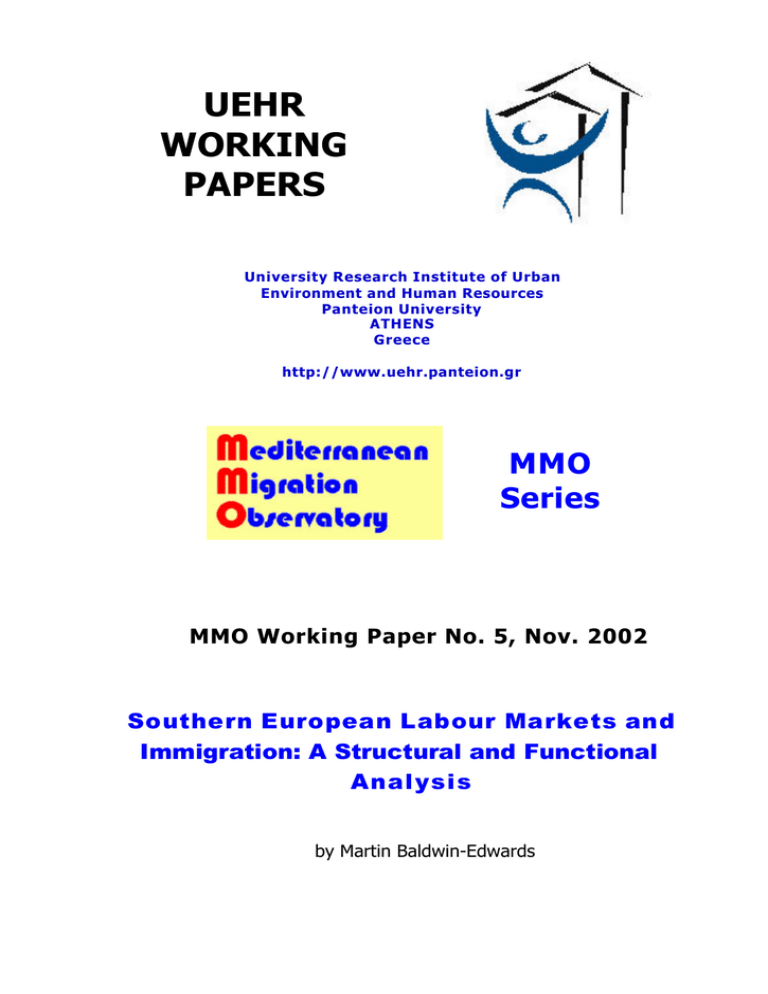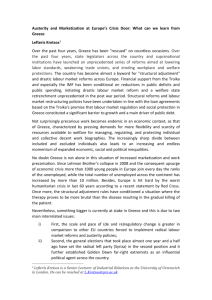UEHR WORKING PAPERS MMO
advertisement

UEHR WORKING PAPERS University Research Institute of Urban Environment and Human Resources Panteion University ATHENS Greece http://www.uehr.panteion.gr MMO Series MMO Working Paper No. 5, Nov. 2002 Southern European Labour Markets and Immigration: A Structural and Functional Analysis by Martin Baldwin-Edwards PUBLISHED IN The Greek Labour Yearbook, 2001, Athens: Panteion University Press [in Greek] SOUTHERN EUROPEAN LABOUR MARKETS AND IMMIGRATION: A STRUCTURAL AND FUNCTIONAL ANALYSIS by Martin Baldwin-Edwards Southern European countries, the ‘new’ immigration countries of the EU (Baldwin-Edwards and Arango, 1999; King and Black, 1997) have experienced alongside mass illegal immigration either already-high unemployment [Spain] or increasing rates of unemployment [Greece and Italy]. This has led to some speculation that immigrants are competing with native labour forces, and thus creating unemployment. Furthermore, all southern Europe has undertaken legalisation programmes, attempting to minimise the extent of illegal residence and work by immigrants. There has been some limited research done on the effects of government policy, but this has been largely confined to Italy. Greece – the country with the greatest per capita problem of illegal immigration – has made no serious evaluation of its policies and is already proceeding with its second legalisation. The aim of this paper is to identify the structural location and role of immigration in the southern European labour markets, since there is evidence to suggest that the characteristics of immigration into southern Europe are distinct from the well-analysed patterns of the 1960s into northern Europe (Baldwin-Edwards, 1999: 2). First, I summarise the existing knowledge on immigrants and labour markets, with a focus on southern Europe. Then, the idea of a specific southern European labour market is posited, and I outline the common characteristics of the labour force, employment and the labour market itself along with nationally idiosyncratic characteristics. Next, the limited comparative data on immigrant location in southern European labour markets is presented. Finally, a brief evaluation is made of immigration into the southern European labour markets, its functions and patterns of location. The existing literature There is no obvious relationship between immigration and unemployment, as it should depend in theory on the relative skill levels of immigrants and natives, in specific economic sectors, and will vary with the economic cycle. If the immigrants are predominantly unskilled, the effect on the host country economy should be a depression of unskilled wages (or increased unemployment if wages are inflexible) whilst wage and income of complementary factors move upward (Coppel at al. 2001: 14). Empirical studies, largely from North America, tend not to support the claim that immigration causes unemployment. European studies are less clearcut, with some research showing small negative effects; others suggest that while there may be a small increase in unemployment in the short run, there is a long run reduction (Gross 1998, 1999). In Europe, immigrants tend to “compensate for the low geographical or functional mobility of the native born population” (Coppel at al. 2001: 16). The effect of immigration on wages is accepted by most research as being of minimal proportions overall, but supporting the theoretical position of reduced low skill wages when a disaggregated analysis is carried out. Thus, a negative impact on low-skill wages and a positive impact on high-skill wages is evidenced (Jaeger, 1996; De New and Zimmerman, 1994; Garson et al. 1987; all cited in Coppel et al. 2001). In southern Europe, little high-quality empirical research has been conducted. A particular problem of such research is that it must focus on the informal economy, owing to the very high proportion of immigrants working or residing clandestinely in southern Europe. In Italy, Venturini analysed data for 14 branches of 5 economic sectors over the period 1980-94, and concluded that there is little competition between irregular labour and the native labour force (OECD 2000b: 26), although there was a measurable depressive effect on agricultural wages. Other research in Greece suggests differential pay rates for immigrants (Lianos et al. 1996), limited sectoral competition (Markova and Sarris, 1997) and regional supply/demand determination of immigrant wages (Baldwin-Edwards and Safilios-Rothschild, 1999). Two OECD studies on illegal immigration in Italy (Palidda 1996, 1999: cited in OECD 2000b: 64) concluded that it is a largely endogenous phenomenon, caused by a burgeoning underground economy and poor state regulation of employment relationships. The analysis of endogenousness is supported by most scholars of the Italian labour market, who emphasise the complementarity of immigrant labour, its rapid growth in the informal sector, and the highly segmented labour market (Reyneri 1999; Quassoli 1999). Perhaps the most insightful overview of immigration and the labour market into southern Europe is that provided by Böhning (1998), in a paper written in the early 1990s. Using a tripartite skills disaggregation [highly qualified, skilled, and unskilled] he shows diagrammatically the badly fitting supply and demand for labour patterns prevailing separately in northern and southern Europe. This he locates in a segmented labour market model. Thus, primary relationships consist of durable jobs with good promotion possibilities, high remuneration except at entry, fringe benefits and a low chance of unemployment; secondary relationships consist of more precarious jobs, with limited promotion possibilities, low pay and benefits, and a higher probability of unemployment. Informal relationships simply contravene the legislation in force, and may or may not include illegal immigrants. Owing to economic and technological change, there is little employment for skilled migrant labour (which is easily satisfied by indigenous labour) whilst there is limited demand for highly qualified and unskilled labour – the latter largely in the informal economy. Figure 1 shows the location of immigrant labour, the double-ended funnel shape in black, in these three sectors. In southern Europe, the picture is even more clearcut: zero demand for skilled labour, unskilled exclusively in the informal sector, and some demand for highly qualified immigrants. Figure 2 shows this. Figure 1 National, OECD and non-OECD labour supplied in different segments of western Europe’s labour markets, 1990s SOURCE: Böhning (1998: Fig. 4.8) 2 Contrasting the 1960s with the 1990s. Böhning notes that not only has the skilled labour segment disappeared, but the unskilled sector has largely become informal in northern Europe. In southern Europe, it has been almost 100% informal before legalisation programmes. These observations on the expansion of the informal economy in all European countries are borne out by research looking across the globe at informal sectors, which concludes that they have expanded everywhere over the 1990s (Enste and Schneider, 1998: Schneider and Enste, 2000). However, it is in southern Europe [in the OECD area] where they are most significant, notably Greece and Italy. Figure 2 National, OECD and non-OECD labour supplied in different segments of southern Europe’s labour markets, 1990s SOURCE: Böhning (1998: Fig. 4.10) SOUTHERN EUROPEAN LABOUR MARKETS As will be understood from some of the above material, there is an implication of difference between the northern European and southern labour markets – with respect to the markets themselves, as well as the role of immigrants. The particularities of southern Europe are worth exploring, since the labour markets should be able to explain the relative ease with which immigrants are economically located – even if their earnings are well below national poverty levels. 3 Labour Force Characteristics Labour force participation in southern Europe has traditionally been very low, although with Portugal rapidly overtaking the other three countries from around 1970 (King and Konjhodzic 1995: 5). The principal cause of the low rate is the lack of paid employment for women – although historically this is rather their exclusion from the formal economy with unpaid activities in small family businesses or agriculture. Today, this exclusion from the formal economy persists, as shown by Table 1. The other contributory factor to the low overall rate are the low rates shown by young people [<24]. Table 1 Participation Rates in Southern Europe, 2000 [%] country Greece Italy Portugal Spain EU av. Total 63,0 59,9 71,0 65,3 69,5 M+F 15-24 38,1 38,1 45,8 48,2 48,3 25-54 77,6 74,2 84,7 77,4 82,7 Total 49,7 46,2 63,6 51,8 59,8 F 15-24 35,4 34,0 41,0 42,9 44,3 25-54 61,7 57,9 77,1 62,4 72,2 SOURCE: OECD (2001a: Tables B and C, Statistical Annex) Of course, if those not in employment are in education, on training courses or even doing military service, they will depress the participation rate, but will nevertheless be part of human capital investment in that country. Statistics released by the OECD recently show some countries with a serious problem of young people neither in employment nor in education. Table 2 shows these data for selected countries. As can be seen, there is not an especial problem in southern Europe [excluding Turkey] for the age group 15-19, although for Spain and Italy the male rates are quite high. However, the age bracket 20-24 shows a clear pattern of low activity by both sexes in Italy, a very low female rate in Greece, with Spain and France not too far behind. Portugal looks like a typical European country, by all the criteria of participation. Table 2 Youth not in education or work, by age group and gender, 1998 [%] Germany France U.K. Portugal Spain Italy Greece Turkey Aged M 3 6 9 6 13 14 7 14 15-19 F 4 4 11 8 12 15 12 44 Aged M 13 17 11 8 18 29 18 20 20-24 F 32 36 62 18 23 20 14 23 SOURCE: OECD (2000a: 71) Given such low participation rates, it might be expected that unemployment levels would be relatively low. In fact, for Spain, Italy and Greece they are the worst in the European Union. Looking in more detail in Table 3, we can see that around 60% of unemployment lasts for over a year in Greece and Italy, that all except Portugal have very high levels of youth unemployment (nearly one third of the age cohort 15-24 is unemployed), very high female unemployment (roughly double the male rate) which is long-term, and extremely high female 4 youth unemployment of over one third of the age cohort. Thus, it seems that the low participation rates of youth and women are a rational response to highly restricted job opportunities in southern Europe. Table 3 Unemployment rates in southern Europe, 2000 [%] M+F F Country Rate* LTU§ 15-24 Rate* LTU§ 15-24 Greece 11,1 56,5 29,5 16,9 61,0 37,7 Italy 10,5 60,8 31,5 14,9 60,9 35,3 Spain 14,1 47,6 25,5 20,6 52,1 33,1 Portugal 4,2 42,9 8,4 5,1 40,0 12,0 EU av 8,3 46,6 15,6 9,9 47,9 17,1 SOURCE: OECD (2001a: Tables A, B, C, G, Statistical Annex) Notes: * standardised rate § >12 months The only remaining major criterion is that of educational level. Table 4 shows the pattern of unemployment and labour market participation by gender and educational level. Looking at relative unemployment levels by educational attainment, Greece stands out as problematic in that there are higher levels of unemployment for those with secondary education, both male and female. The relative levels of unemployment for those with tertiary education are also high in Greece. Italy shows a more expected pattern of lower unemployment rates for higher levels of education, with very high unemployment and low participation of low-education females. Spain, too, shows a pattern similar to that of Italy. Portugal shows a similar problem to Greece with relatively high rates for those with secondary education, although an unusually low unemployment rate and high participation rate of women with tertiary education. Table 4 Unemployment and participation rates in southern Europe, by gender and educational level, 1998 M F < u.s. = u.s. tertiary < u.s. = u.s. tertiary RATES OF: Unemployment 5,5 6,6 5,3 13,7 17,3 10,3 56,9 83,2 Participation 81,6 89,4 90,8 41,1 Italy Unemployment 7,8 5,7 4,9 16,6 11,1 9,3 32,6 66,1 81,3 Participation 75,2 85,7 91,8 Portugal Unemployment 3,9 4,1 3,0 4,6 6,2 2,1 Participation 89,0 90,5 95,9 69,0 82,4 90,9 Spain Unemployment 10,5 7,8 6,9 22,8 19,8 16,0 Participation 82,2 91,2 91,4 39,5 68,4 82,7 EU av Unemployment 9,8 6,3 4,2 13,8 8,3 6,3 Participation 77,8 86,9 91,4 46,3 72,0 84,3 Country Greece SOURCE: OECD (2001a: Table D, Statistical Annex) Notes: < u.s. = less than upper secondary education = u.s. = completed upper secondary education 5 Table 5 shows distribution of the population by educational attainment in these countries. These data help to explain some of the differences revealed in Table 4. First, both Portugal and Spain have very high proportions of both sexes with a very low level of education, so it can be expected that those with secondary education are less likely to be unemployed. Secondly, Greece and Italy have roughly double the proportion of both sexes with secondary education, which partly explains the high unemployment rate for this level of education in Greece. Finally, Greece and especially Spain have very high levels of tertiary education, with Portugal and Italy showing very low levels. Thus, employment for this level appears to be a problem in Greece for both sexes, but only for women in Spain. Table 5 Share of the population 15-64 by educational attainment, 2000 Greece Italy Portugal Spain EU av < u.s. = u.s. 47,7 36,8 55,3 36,5 79,9 13,5 59,5 19,9 36,2 43,8 M F tertiary < u.s. = u.s. tertiary 15,5 49,0 38,2 12,8 8,2 55,1 37,0 7,9 6,5 74,4 16,0 9,6 20,7 59,9 19,8 20,2 20,0 39,6 42,5 17,9 SOURCE: CEC (2001: 23) In summary, the outstanding characteristics of the labour force in southern Europe seem to be the following: • • • • Very low participation by young people and women in Greece and Italy Very high unemployment rates of young people and women in Greece, Italy and Spain Lack of employment for women of all levels of education in Spain, and for both sexes with secondary school education or higher in Greece Low education levels, except in Greece [and in Spain for tertiary education] Employment Characteristics Southern Europe has followed the pattern of industrialised countries in decline in manufacturing industry and expansion of the services sector, although all except Italy retain overlarge agricultural employment shares despite continued reduction of employment in agriculture. The services sector is rather undeveloped in Greece and Portugal, which is the more disquieting given the extent of tourism. It must be borne in mind, however, that both agriculture and the tourism industry are important parts of the informal economy, with massive under-reporting of employment likely in both cases. In the agricultural sector especially, heavy reliance on temporary seasonal labour has been a major factor in providing work for illegal immigrants, as discussed below. Table 6 shows employment by sector for 1991 and 2000. 6 Table 6 Employment by sector, 1991 and 2000 [%] services industry agriculture 1991 2000 1991 2000 1991 2000 Greece 51,8 58,0 26,8 23,3 21,4 18,7 Italy 61,1 65,5 31,8 29,7 7,1 4,8 Spain 60,2 63,5 30,4 30,0 9,4 6,6 Portugal 53,5 58,0 34,0 31,2 12,5 10,8 EU av 62,7 68,8 31,3 26,9 6,0 4,4 SOURCE: CEC (2001: 110 et seq.) Across the EU, higher GDP growth over the late 1990s has translated into higher employment rates; in all EU countries except Greece, the elasticity of employment growth to GDP growth has increased over the period 1995-2000. Whereas the elasticity was EU average 0,2 from 1980-90, Greece’s was 1,5; now, with the EU average at 0,5 for 1995-2000, with Spain and Italy well above that, Greece’s has declined to 0,2 (CEC, 2001: 54). This is a disturbing trend, which suggests lack of policy for job creation in Greece, along with the possibility of the informal sector [and particularly the work of illegal immigrants] making a significant structural impact on the Greek economy. This observation is supported also by the data for change in GDP per hour worked over the reference period 1995-1999: whereas all other EU countries experienced declining rates, Greece doubled its annual rate of change from just over 1% to 2%. [Although change in capital intensity could explain these data, that rate of change is not very different in 1995-1999 from the 1980s.] Atypical forms of employment across southern Europe exhibit a different pattern from the rest of Europe: whilst part-time working remains unattractive throughout the region (especially in Greece), temporary contracts are extremely prevalent in Spain and fairly high and rapidly increasing in Portugal, Greece and Italy. These atypical forms of employment are thought to be concentrated in specific sectors – most notably the retail sector for part-time working and services/tourism for temporary contracts. Also, there is a gender asymmetry in that more than 50% of new jobs for women are part-time (OECD 2001c: 66). Youth participation in part-time employment has been increasing throughout the EU over the period 1995-2000, particularly for reasons of training combined with employment. However, there is great variation between EU countries, with southern Europe showing the lowest levels [6-12% of youth employment, cf 2060% in N. Europe]. Also notable is the very low proportion in southern Europe undertaking training for work – well under the EU average of 48%. Self-employment continues to be extremely high in Greece – three times the EU average – and nearly double the EU average in Italy and Portugal: these partly reflect the large agricultural sectors in Portugal and Greece, but also the great extent of small family businesses in Italy as well as in Greece and Portugal. Table 7 shows the proportions of selfemployment, part-time and fixed contracts. 7 Table 7 Self-employment, part-time and fixed term contracts, 1991 and 2000 [% total employment] Self-empl. Part-time Fixed term 1991 2000 1991 2000 1991 2000 Greece 46,7 44,0 3,9 4,3 6,8 7,0 Italy 27,5 26,2 6,0 8,4 5,2 7,5 Spain 18,8 16,6 4,5 8,0 26,2 26,7 Portugal 26,5 27,5 7,9 10,8 10,8 14,8 EU av 15,6 14,8 13,9 17,7 9,2 11,4 SOURCE: CEC (2001: p. 110 et seq.) The new service economy Looking at three relatively new forms of employment, there is a serious deficit across southern Europe. These are ‘high-tech’ employment, ‘high-education’ employment and ‘knowledgeintensive’ employment – defined below. High-Tech • • • • Manufacturing of: chemicals, machinery, office machinery, electrical equipment, tv and communications equipment, medical and optical equipment, transport vehicles. Post and telecommunications Computer and related Research and development High-education • • • • • • • • Manufacturing of office machinery and equipment Computer and related Research and development Other business activities Education Health and Social Work Activities of membership organisations Extra-territorial organisations Knowledge-intensive • • • • • • • • • • • • • • Water transport Air transport Post and telecommunications Financial intermediation Insurances and pension [non-state] Auxiliary activities to financial intermediation Real estate Rental of machinery Computer and related Research and development Other business activities Education Health and social work Recreational, cultural and sporting [There are activities common to two or all three of these sectors, e.g. ‘computer and related’ is in all three] 8 Table 8 details the relative importances of these sectors in total employment across southern Europe. Although Italy approaches the EU average, it is actually considerably below the northern European countries in high-education and knowledge-intensive employment. The rest of southern Europe has very low proportions of this skilled employment. Table 8 Employment in the knowledge-based economy, 2000 [% of total employment] Italy Spain Greece Portugal EU av High-tech High-education Knowledge-intensive 11 21 27 18 24 8 4 17 23 5 16 21 11 26 33 SOURCE: CEC (2001: pp 32-34) Labour mobility vs job tenure Both geographic and labour market mobility are thought to be essential components of an efficient labour market, with Europe lagging behind the USA in both respects. This is likely to be more important for highly skilled occupations than unskilled, particularly in science and technology. Table 9 shows job mobility, defined as moving from one job to another over two adjacent calendar years, as a proportion of total high skilled science and technology employment. Italy and Greece exhibit the lowest levels of high-skill mobility, although increasing markedly over a short time period. Spain has the highest rates in the EU. Table 9 Mobility rates of the highly skilled in science and technology, by gender [%] F Greece Italy Spain Portugal Germany France UK M 1995 1999 1995 1999 4,6 5,6 3,6 4,9 3,4 5,4 2,4 4,4 16,2 17,2 12,6 12,0 n.d. 7,6 n.d. 7,9 6,5 7,8 5,5 7,2 6,5 9,1 6,5 8,0 10,6 12,2 9,5 11,9 SOURCE: CEC (2001: 50) Job tenure is clearly an important aspect of the labour market, and gives some indication of flexibility and adaptability. Table 10 shows tenure rates for southern Europe, defined as having held a specific job for more than 2 years. As can be seen clearly, Greece and Italy have very high rates of tenure of over 2 years, whilst Spain had a very low rate in 1995 but has shifted upward to more nearly approach the EU average. 9 Table 10 Job tenure in southern Europe, 1995 and 2000 [%] 1995 2000 1-2 years >2 years 1-2 years >2 years Greece 84,7 6,1 84,3 6,6 Italy 86,5 7,8 81,0 6,7 Spain 5,6 66,1 10,2 68,9 Portugal 8,2 80,7 9,2 76,2 EU av 8,5 76,7 10,1 73,5 SOURCE: CEC (2001: 72) Job Quality Using data from the European Community Household Panel 1994-1996, the Commission catalogues employment into 4 categories : ‘dead-end’, ‘low pay’, ‘reasonable quality’ and ‘good quality’. These are defined as: Dead-end: fixed-term or short-term contracts or without formal contract; nonsupervisory function; do not offer employer-provided training. Low-pay: hourly wages below 75% of national median but provide either job security or employer training and career prospects. Reasonable quality: decent pay and either job security or employer training. Good quality: decent pay and both job security and employer training. The smallest proportion of good quality jobs is reported for Greece (17%), Portugal, Italy and Spain, with an EU average of 39%. The highest ratio of dead-end jobs is found in Spain (27%), Greece and Portugal, with an EU average of 6%. The four southern European countries provide a high proportion of ‘reasonable quality’ jobs (slightly above the EU average), presumably because of their emphasis on permanent posts with no training or career prospects. (CEC 2001: 74) More detailed analysis of the constituents of the ‘dead-end’ job category reveals very high levels of university graduates in Greece and Spain, with no comparable levels elsewhere in the EU (CEC 2001: 79). Summary Employment patterns have some divergent and some common patterns across southern Europe. Examining first the common patterns: • Very low part-time employment, especially combined with youth training schemes • An increasing use of temporary contracts, especially in Spain and Portugal • Weak development of the ‘knowledge economy’ sector [partially excepting Italy] • Very little employer training and career development – ‘good quality’ jobs The divergent patterns are: • Very low employment growth in Greece, relative to GDP • Very high self-employment in Greece [twice that of rest of southern Europe] • Very high agricultural employment in Greece [4 times EU average] • Very high temporary employment in Spain [more than double EU average] • Very low mobility of the highly skilled in Greece and Italy • Very high job tenure in Greece and Italy • Very high proportions of university graduates in ‘dead-end’ jobs in Greece and Spain 10 Towards a synthesis of labour supply and demand characteristics in southern Europe Several features of southern European labour markets stand out as anomalous in the EU context: 1) The combination of low participation (except in Portugal) and high unemployment 2) The apparent mismatch of higher educational levels with better employment, despite overall low levels of education 3) The general lack of employment for women 4) High tenure rates of jobs but without employer training and career development 5) New employment tends to be temporary, or sometimes part-time 6) The lack of employment or training for young people These features describe labour markets with little flexibility and very poor match of supply and demand, despite reforms which have been undertaken in the last decade. Some analysts have attributed this to governmental regulation, which has prevented rational business responses to market changes. Raines (1998) using 1992 data examines regulation across the EU for recruitment, dismissals, part-time working, temporary working and atypical hours. Table 11 summarises his results. Table 11 Regulation of employment, country rankings, 1992 Dismissal Sp P I Gr G F N B Irl Dk UK Recruitment I Sp P B G F Irl N UK Dk [Gr – no data] Part-time Gr I Sp B P G Dk N F Irl UK Temporary B I G F Gr P Sp N Dk Irl UK Atypical hours P Gr Sp F N F B Irl I Dk UK SOURCE: Raines (1998: 12-23) Note: ranked in order of diminishing regulation As can be seen clearly, the southern European countries dominate the rankings for all categories except temporary working. Raines, examining correlation between the degree of regulation and the actual practices of employment, finds good correlation of rankings, especially for atypical employment and atypical hours [an exception is Greece, where atypical hours are very high]. Further, he notes that the effect of strict dismissal and recruitment regulation, especially in Italy and Spain, has been to promote the informal economy as well as high reliance on temporary contracts in Spain. A more recent evaluation of employment protection legislation undertaken by the OECD in 1998 compares strictness of regulation in 1990 and 1998. Table 12 summarises their findings. 11 Table 12 Strictness of Employment Protection Legislation, 1990 and 1998 Regular contracts Temporary contracts Regular and temporary 1990 1998 1990 1998 1990 1998 Greece 4,5 4,5 3,6 3,5 2,8 2,6 Italy 3,0 3,0 5,3 3,6 4,2 3,3 Spain 3,8 2,8 3,5 3,7 3,7 3,2 Portugal 5,0 4,3 3,5 3,2 4,2 3,7 Germany 2,9 3,0 4,2 2,5 3,6 2,8 France 2,4 2,5 3,0 3,7 2,7 3,1 UK 0,7 0,7 0,3 0,3 0,5 0,5 SOURCE: OECD (2001c: 65) Note: index ranges from 0 to 6, with higher values representing stricter regulation. Thus, by the late 1990s, although southern Europe continues to have tightly regulated labour markets in comparison with the Anglophone world, they are broadly similar to continental European patterns. The principal issue, given adherence to long tenure employment and low mobility, is how extensive is on-the-job training in order to improve productivity levels and also to keep pace within the Eurozone. As has already been shown, such jobs are rare in southern Europe. Data on R&D reveal the same story. Southern Europe lags well behind the EU in expenditure as proportion of GDP, per capita, and as a proportion of domestic product of industry – mostly one third of the EU average. The exception is Greece, where industry spends only 15% of the EU average on R&D, and per capita expenditure [GERD per capita] is so low as to be similar to Eastern Europe and Turkey (OECD 2000c). A similar pattern exists with public expenditure on active labour market measures across southern Europe, where already low budgets have been cut in Spain in order to fund passive measures. Greece has the lowest level of expenditure in the EU on active measures [the same as Hungary’s]; Italy cannot even provide any statistics, although the limited data given show that it is very low expenditure (OECD, 2001a: Table H, Statistical Annex). The only possible conclusion from all these data, is that neither the state nor the private sector in southern Europe attaches much importance to educational levels, vocational training, and on-the-job training. It raises a fundamental question about resource allocation and the criteria for employment. Gangl (2000) has undertaken extensive comparative analysis of training systems and labour markets in the EU, using the EC Labour Force Survey data 1992-1997. He concludes that southern Europe is a special case in the EU, with: 1) low rates of mobility in early career 2) low qualification effects on market exclusion, especially unemployment 3) high qualification effects on status attainment (Gangl, 2000: 24) Equally revealing is his finding that Spain has shifted from a southern European pattern to more closely resemble a group of northern European countries including Belgium, France and the UK. These latter countries exhibit a strongly experience-based pattern of labour market incorporation, with entry at the lowest levels – often called an ILM pattern (Internal Labour Market). Those European countries with extensive vocational training systems – OLM, or Occupational Labour Market – [Austria, Denmark, Germany, Netherlands] emphasise skills at labour market entry and attach much less importance to experience. The southern European 12 pattern exhibits features of both models, forming a rather incoherent system of labour market incorporation. Since many of the institutional frameworks crudely resemble the Germanic OLM type (although without the stratified pre-employment vocational training system), it is significant that Spain has shifted to an ILM pattern. This may simply be because this approximates to a free market approach, in the absence of sophisticated state intervention and training schemes. These findings are broadly in line with the observations in this paper, which contradict the broad policy recommendations of the European Commission (CEC, 2000, 2001). Their belief is that more education and training will solve labour market problems and minimise unemployment risk for the individual. In southern Europe this does not hold, as evidenced by the large proportions of unemployed graduates and graduates in dead-end and semi-skilled jobs. Clearly, the problems of job allocation and disinterest in research and development, vocational training and continuous job-training are culturally located: simple reform is out of the question. IMMIGRANTS IN SOUTHERN EUROPE The role of immigrants in southern European economies is complex and multi-faceted: there are many different nationalities, performing many different sorts of work, with some common patterns across the region alongside national idiosyncrasies. Throughout the last two decades, the principal difficulty of analysis has been the illegal status of large numbers of immigrants; despite many legalisation programmes, this remains a major obstacle for the following reasons: 1) many illegal immigrants did not apply for legalisation, or were rejected 2) many who were given temporary permits were unable or unwilling to renew them and lapsed back into illegality 3) the habit of southern European states of giving residence without the right to work – thus promoting the black economy 4) the inability of all four countries’ bureaucracies to provide up-to-date collated statistics of all immigrants residing and/or working lawfully 5) many more illegal immigrants are thought to have arrived since the legalisation programmes finished Using OECD-SOPEMI (2001) estimates of the foreign populations in 1998, supplemented by data from a Eurostat/NIDI survey (Icduygu and Unalan, 2001), it is apparent that there are great differences in the extent of immigration across southern Europe. Table 13 summarises the data. Table 13 Total population, working age population, and estimated immigrant stocks, 1998 [000s] Greece Italy Spain Portugal Total Population 10.300 15-64 Legal 6.900 ??? Illegal [est] ??? 57.000 22.500 1.250 39.100 26.400 *700 10.000 6.800 179 250 200 100 Total Immigrants/ population 8009-10% 1.000 1.500 2,6% 900 2,3% 279 2,8% Work permits ??? 614,6 190,6 88,6 SOURCES: OECD (2001a, 2001b), CEC (2001), Icduygu and Unalan (2001) Note: * some 400.000 are EU nationals 13 As can be seen from these data, first of all Greece has an exceptionally large immigrant population of around 10% of total population, whereas Spain, Italy and Portugal have figures well below the European average. Secondly, the number of valid work authorisations is very low in all countries except Portugal [where residence permits give the right to work]. Owing to the complex bureaucracy and chaotic management of the 1998 Greek legalisation programme [see e.g. Skordas, 2000], along with work permit numbers not referring to numbers of workers but to pieces of paper of varying durations, it is not possible even to estimate crudely the number of legally present immigrant workers in Greece. OECD comparative statistics on participation and unemployment rates of foreigners (OECD 2001a: Table 5.3) reveal in southern Europe, a distinctive pattern of higher immigrant participation rates and similar or lower unemployment rates than natives. Across the rest of Europe, the converse prevails – lower participation and higher unemployment. The southern European pattern is probably caused by the highly selective granting of work permits, leaving very large numbers of immigrants in the informal sector. Thus, the actual participation rates of illegal plus legal immigrants may be very different. Indeed, the very notion of participation may be inappropriate, owing to extensive underemployment and seasonal working. Of those permits granted, there tends to be concentration in certain sectors. Table 14 shows the latest data. Table 14 Foreign employment by economic activity, 1998-9 [%] Greece Italy Spain Portugal Agriculture and fishing Mining + manufacturing construction Retail + wholesale 3,5 6,0 9,0 3,3 19,3 29,0 11,6 17,4 26,6 9,4 8,8 18,6 19,0 17,7 26,1 24,3 Health, Education, social services 5,9 11,1 14,2 17,9 households Public admin Other services 19,9 10,4 16,4 5,1 0,8 3,0 1,3 1,8 5,0 13,4 12,5 10,6 SOURCE: OECD (2001a: Table 5.4) Note : highlighted numbers indicate over-representation in that sector Some clear patterns emerge from these data. There is a common feature of high employment of housekeepers, mainly female Filipino, across southern Europe. There is also a concentration of immigrant employment in construction and industrial manufacturing, which is most pronounced in Italy and Greece. Although immigrants are extensively utilised in the agricultural sector, the data given above do not reveal this so clearly. This is probably because of the general illegality of agricultural immigrant workers, owing to strict limits and onerous bureaucratic conditions set by states on such employment. Further data on work permits suggest a very different pattern of immigrant employment between the Iberian peninsula and Italy/Greece. Looking at white collar / blue collar data for native and immigrant workers, the ratio is similar for immigrant workers and natives in Spain and Portugal. In Italy, the immigrant proportion in white collar jobs is 25% as opposed to 42%, in Greece it is 10% as opposed to 40%. A comparable pattern occurs with self-employment, with similar rates for natives and immigrants in Spain and Portugal, but 18% compared with 28% in Italy, and only 8% compared with the very large proportion of 43% in Greece. These figures cover a small fraction of the immigrants in Greece and Italy [150,000 and 210,000 respectively], thus the underskilled character of mass Albanian immigration cannot be an 14 explanation. Rather, it seems to lie in the sort of work which either the private sector offers to immigrants or that the state permits; in the case of self-employment, this is clearly a matter only of government policy. TOWARDS SOME CONCLUSIONS Immigration into northern European countries was traditionally used as a flexible labour supply, with the intention of laying off workers in recession and engaging more at times of economic boom – usually referred to by its German name, a Gastarbeiter policy. To some extent this continues, since the unemployment rates of immigrant workers exceed those of natives during recessionary periods. However, longterm and family migration has delegitimated that approach: increasingly northern Europe has had to accept multiculturalism and nondiscrimination principles. In southern Europe, the relatively new phenomenon of immigration has not served a similar function, although some nascent patterns of multicultural behavour are emerging, especially in Italy and Spain. The role of immigrants in southern Europe has been quite different – to compensate for structural defects in the labour markets. These defects are of three types: insufficient labour supply inflexible labour markets through over-regulation uncompetitive low-productivity sectors (a) Insufficient labour supply The low participation rates of young people across southern Europe actually reflect a strategy to maximise their employment status by delaying market entry, usually by studying, until an appropriate position can be found. As was noted above, Gangl’s research concludes that high qualifications do not minimise the chance of unemployment, but do guarantee a high status should employment be gained. Thus the young populations of Greece and Spain are highly educated, but face unemployment prospects or medium education employment, as there are insufficient high quality jobs. Thus, young immigrants are able to find low quality employment – especially of the type that requires younger workers – if they accept the bad working conditions that the native population rejects. This is particularly true in agriculture, heavy and dirty industry for men; for women, the main activities seems to be live-in housekeeping and cleaning. However, in Spain and Portugal there is not a high proportion of medium educated workers, and this appears to have opened up possibilities for white collar immigrant employment. In Italy and especially Greece, there is a large supply of such native workers, therefore immigrant employment in that areas is largely absent. Presumably, the Greek state has taken a similar attitude to self-employment, arguing that there is already too much of it in the economy. (b) Inflexible labour markets As shown above [Tables 11 and 12], employment regulation has been onerous in southern Europe, with respect to hiring practices, part-time working etc. Illegal employment of nationals is not an attractive option, for either employer or employee: however, illegal employment of illegal immigrants is very attractive. First, it is harder for the state to detect such employment. Secondly, the employment can be as flexible as the employer needs, since not only do no labour standards apply, but the immigrant is unlikely to complain whereas a native might. 15 Thirdly, there can be additional benefits for the employer – such as avoiding social security payments completely, refusing to pay the illegal immigrant who can do little about it, ignoring health and safety legislation, etc. Thus, we can see how the informal economy blossomed with the incorporation of illegal immigrants, although its structural importance and social acceptance predated mass immigration in all four countries (Williams and Windebank, 1995). Although a significant amount of state regulation has been weakened, the traditional toleration of the informal sector will take some time to disappear, and it is not clear that reform has been sufficient except in Spain. (c) Uncompetitive low-productivity sectors There are two basic types of compensation in this category. The first is straightforward: lowwage or seasonal employment which the native population could not subsist on, such as agricultural work, but immigrants accept as it is better than anything available in their home country. In this way, immigrants facilitate the continuation of sectors which might otherwise be economically unviable (Baldwin-Edwards and Safilios-Rothschild, 1999). The second category relates to the complementary nature of immigrant employment, which actually boosts the living standards of white collar native workers. As was discussed above, southern Europe has poor training of its workforce, both before employment and during it. This lack of training has implications for productivity levels and global competitiveness, especially within the Eurozone. Thus, low-paid unskilled or semi-skilled immigrants are able to compensate for the low productivity of native workers: this role of immigrants is likely to become increasingly important in the near future. Already, there have been signs that much of economic growth in Greece, for example, has been through the underpaid work of illegal immigrants. The labour market and state regulation Broadly speaking, Bohning’s model of immigrant incorporation into southern European labour markets seems to hold, although with some national idiosyncrasies. Over the last decade, immigrants have been moving back and forth between the informal sector and the secondary labour market, oscillating with the various legalisation programmes. However, one has only to look at the small number of work permits given across Spain, Italy and Greece, their limited durations, and the general policy orientation, to realise that southern European governments wish to perpetuate informal labour markets. The economic advantages are too obvious, at a time when policy instruments are being reduced [exchange rates, fiscal policy, monetary policy…]. However, the intelligent strategy would be to upgrade the labour force, not with general education but with focused employability skills. This should also encompass R&D, not only as training for the labour force, but also as a central feature of all advanced economies. With economic development, professional skills and career occupational structures, perhaps the informal economy would be less needed and would shrink to more manageable proportions. 16 REFERENCES Baldwin-Edwards, M. (1999): ‘Where Free Markets Reign: Aliens in the Twilight Zone’, in M. Baldwin-Edwards and J. Arango (op. cit.) Baldwin-Edwards, M. and J. Arango (eds): Immigrants and the Informal Economy in Southern Europe. London: Frank Cass Baldwin-Edwards, M. and C. Safilios-Rothschild (1999): ‘Immigration and Unemployment in Greece: Perceptions and Realities’, South European Society & Politics 4/3 Böhning, W.R. (1998):’Top-end and bottom-end labour import in the United States and Europe’, in Hans van Amersfoort and J. Doomernik (eds): International Migration: Processes and Interventions, Amsterdam: IMES and Het Spinhuis Publishers CEC (2000): Employment in Europe 2000, Luxemburg: Commission of the EC CEC (2001): Employment in Europe 2001, Luxemburg: Commission of the EC Coppel, J., J-C Dumont and I. Visco (2001): ‘Trends in Immigration and Economic Consequences’, OECD Economics Department Working Paper 284, ECO/WKP(2001)10 Enste, D. and F. Schneider (1998): ‘Increasing Shadow Economies all over the World – Fiction or Reality?’, Discussion Paper 26, IZA, Bonn Gangl, M. (2000): ‘European Perspectives on Labour Market Entry’, Working Paper 24, MZES, Mannheim Gross, D. (1998): ‘Immigration Flows and Regional Labor Market Dynamics’, IMF Working Paper WP/98/47 Gross, D. (1999): ‘Three Million Foreigners, Three Million Unemployed? Immigration and the French Labour Market’ , IMF Working Paper WP/99/124 Icduygu, A. and T. Unalan (2001): ‘Tides between Mediterranean Shores: Undocumented Migration in the South of Europe’, conference paper given at the IUSSP General Population Conference XXIV, Brazil: Session S26 King, R. and R./ Black (eds) (1997): Southern Europe and the New Migrations, Brighton: Sussex Academic Press King, R. and I. Konjhodzic (1995): ‘Labour, Employment and Migration in Southern Europe’, Research Paper 19, Geography Laboratory, University of Sussex, UK Lianos, T., A. Sarris and L. Katseli (1996): ‘Illegal Immigration and Local Labour Markets: The Case of Northern Greece’, International Migration XXXIX/3, pp 449-484 Markova, E. and A. Sarris (1997): ‘The Performance of Bulgarian Illegal Immigrants in the Greek Labour Market’, South European Society & Politics 2/2, pp 57-77 OECD (2000a): OECD Observer 233, October 2000, Paris: OECD OECD (2000b): Combating the Illegal Employment of Foreign Workers, Paris: OECD OECD (2000c): OECD in Figures, 2000 Edition, Paris: OECD OECD (2001a): Employment Outlook, Paris: OECD OECD (2001b): Trends in International Migration SOPEMI, Paris: OECD OECD (2001c): Economic Surveys: Greece 2000-2001, Paris: OECD 17 Quassoli, F. (1999): ‘Migrants in the Italian Underground Economy’, International Journal of Urban and Regional Research, 23/2, pp. 212-231 Raines, P. (1998): ‘Labour standards and industrial restructuring in Western Europe’, Employment and Training Paper 17, ILO, Geneva Reyneri, E. (1999): ‘The Mass Legalization of Migrants in Italy’, in M. Baldwin-Edwards and J. Arango (op. cit.) Schneider, F. and D. Enste (2000): ‘Shadow Economies Around the World: Size, Causes and Consequences’, IMF Working Paper Skordas, A. (2000): ‘The Regularisation of Illegal Immigrants in Greece’, in P. de Bruycker (ed): Les regularisations des étrangers illégaux dans l’Union européenne, Bruxelles: Faculté de Droit de l’Université Libre de Bruxelles Williams, C. and J. Windebank (1995): ‘Black Market Work in the European Community: Peripheral Work for Peripheral Localities?’, International Journal of Urban and Regional Research 19/1, pp. 23-39 18








